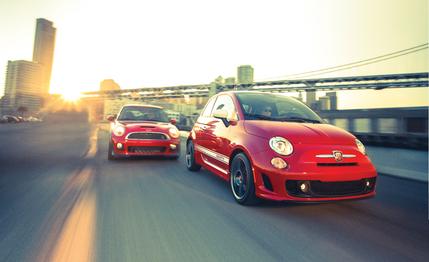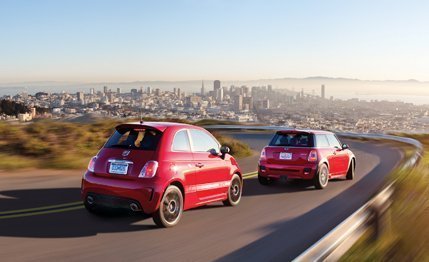
 Comparison Tests
Comparison Tests


If you go through the hellish nightmare of creating a car, you earn the right to scrawl your name on it. Two men, John Cooper of England and Karl Abarth of Austria—later, Carlo Abarth of Italy—went racing in the late 1940s with their own machines. Cooper etched his name into history by putting the engine behind the driver and dusting competitors with his light, lesser-powered formula cars. A motorcycle racer at first, Abarth cozied up to Fiat and made special editions and performance parts.


But their widespread notoriety wasn’t ensured until the late 1950s, when a couple of plebeian city cars came along that were cut-buck cheap, gastropod slow, and ripe for improvement. The only reason your dentist doesn’t associate the name “Cooper” with a tire or a person who makes barrels is because of what John Cooper did to the original 1959 BMC Mini and its subsequent iterations. And the only reason your dentist knows an Abarth—okay, your dentist probably doesn’t know an Abarth from an abacus. At least, not yet. But if he or she did, it would be because of the black scorpions Mr. Abarth—born a Scorpio—applied to the 1957 Fiat 500 and its subsequent iterations.
Cooper and Abarth made good businesses out of somebody else’s small cars, and now Mini (a.k.a. BMW) and Fiat (a.k.a. Chrysler Group, LLC) are collecting on the favor. The cars are still dinky and the power outputs still modest, but the personalities—along with the price tags—have been terrifically amplified.


In the Fiat 500 Abarth, it’s about 18 psi worth of amplification from a Honeywell turbo pressurizing the 1.4-liter MultiAir four-cylinder to 160 horsepower and 170 pound-feet of torque through two intercoolers in the car’s cheeks. Trust us: The base Fiat 500 in no way suffers from another 59 horses, nor is its virtue besmirched by a lower, stiffer suspension on Koni shocks, Pirelli P Zero Nero tires (here on forged aluminum 17-inchers, a $1000 option), aero accents, huggier bucket seats, a tighter shift feel in its five-speed manual, and an exhaust that sounds like it’s missing a couple feet of tubing.


You start at $22,700 and hit $25,050 with the wheels, the $600 Convenience package (automatic climate control and satellite radio), a $400 TomTom navigation unit, and the white mirrors and body stripe ($350).
The Cooper name has been on the new Mini since its 2001 reboot and, for the past few years, has graced every Mini model sold in the U.S. The Mini Cooper S John Cooper Works debuted in 2003 as a dealer-installed kit that made the “JCW” the baddest Mini in the auto mall. After the Mini’s 2007 redesign, the Works returned to the top of the lineup as a factory trim level. Works treatments for most of the Mini fleet are already here or coming.
Today, the JCW’s 1.6-liter, turbocharged and direct-injected four-cylinder produces 27 more horsepower and 15 more pound-feet of torque than a Cooper S: 208 and 207, respectively. The suspension is lowered and stiffened, with Brembo calipers inside dedicated 17-inch wheels and Dunlop SP Sport run-flat tires. Track days are kept in mind with dynamic traction control, which makes the computer intervention less intrusive, and an electronic version of a limited-slip differential, which uses the brakes to slow a spinning front wheel. Butch and blistered bumpers, lower side sills, and interior decorations set a JCW apart, along with a $6800 dollop to the Cooper S’s price, which rises to $30,600.
Add the dual-pane sunroof for $1000, heated front seats for $500, and a Bluetooth and USB/iPod adapter for another $500, and you have the car pictured here, priced at $32,600—a Mini with a very maxi sticker.
Two modern midget cars that still bear the names of the master toy makers are on sale. Which plays harder? Let’s pull-start ’em and see.